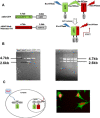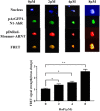Interaction between AhR and HIF-1 signaling pathways mediated by ARNT/HIF-1β
- PMID: 35473600
- PMCID: PMC9044668
- DOI: 10.1186/s40360-022-00564-8
Interaction between AhR and HIF-1 signaling pathways mediated by ARNT/HIF-1β
Abstract
Background: The main causes of lung cancer are smoking, environmental pollution and genetic susceptibility. It is an indisputable fact that PAHs are related to lung cancer, and benzo(a) pyrene is a representative of PAHs. The purpose of the current investigation was to investigate the interaction between AhR and HIF-1 signaling pathways in A549 cells, which provide some experimental basis for scientists to find drugs that block AhR and HIF-1 signaling pathway to prevent and treat cancer.
Methods: This project adopts the CYP1A1 signaling pathways and the expression of CYP1B1 is expressed as a measure of AhR strength index. The expression of VEGF and CAIX volume as a measure of the strength of the signal path HIF-1 indicators. Through the construction of plasmid vector, fluorescence resonance energy transfer, real-time quantitative PCR, western blotting and immunoprecipitation, the interaction between AhR signaling pathway and HIF-1 signaling pathway was observed.
Results: BaP can enhance the binding ability of HIF-1α protein to HIF-1β/ARNT in a dose-dependent manner without CoCl2. However, the binding ability of AhR protein to HIF-1β/ARNT is inhibited by HIF-1α signaling pathway in a dose-dependent manner with CoCl2.
Conclusion: It is shown that activation of the AhR signaling pathway does not inhibit the HIF-1α signaling pathway, but activation of the HIF-1α signaling pathway inhibits the AhR signaling pathway.
Keywords: Aryl hydrocarbon receptor; Aryl hydrocarbon receptor nuclear translocator; Benzopyrene; CoCl2; Hypoxia-inducible factor-1α.
© 2022. The Author(s).
Conflict of interest statement
The funding organizations played no role in the study design; in the collection, analysis, and interpretation of data; in the writing of the report; or in the decision to submit the report for publication.
Figures







Similar articles
-
Dissociation of the AhR/ARNT complex by TGF-β/Smad signaling represses CYP1A1 gene expression and inhibits benze[a]pyrene-mediated cytotoxicity.J Biol Chem. 2020 Jul 3;295(27):9033-9051. doi: 10.1074/jbc.RA120.013596. Epub 2020 May 14. J Biol Chem. 2020. PMID: 32409577 Free PMC article.
-
Hypoxia perturbs aryl hydrocarbon receptor signaling and CYP1A1 expression induced by PCB 126 in human skin and liver-derived cell lines.Toxicol Appl Pharmacol. 2014 Feb 1;274(3):408-16. doi: 10.1016/j.taap.2013.12.002. Epub 2013 Dec 16. Toxicol Appl Pharmacol. 2014. PMID: 24355420 Free PMC article.
-
Diminished carcinogen detoxification is a novel mechanism for hypoxia-inducible factor 1-mediated genetic instability.J Biol Chem. 2010 May 7;285(19):14558-64. doi: 10.1074/jbc.M109.076323. Epub 2010 Mar 12. J Biol Chem. 2010. PMID: 20228066 Free PMC article.
-
Hypoxia-inducible aryl hydrocarbon receptor nuclear translocator (ARNT) (HIF-1β): is it a rare exception?Mol Med. 2014 May 27;20(1):215-20. doi: 10.2119/molmed.2014.00032. Mol Med. 2014. PMID: 24849811 Free PMC article. Review.
-
Regulatory crosstalk and interference between the xenobiotic and hypoxia sensing pathways at the AhR-ARNT-HIF1α signaling node.Chem Biol Interact. 2014 Jul 25;218:82-8. doi: 10.1016/j.cbi.2014.05.001. Epub 2014 May 10. Chem Biol Interact. 2014. PMID: 24824450 Free PMC article. Review.
Cited by
-
Lung cancer associated with combustion particles and fine particulate matter (PM2.5) - The roles of polycyclic aromatic hydrocarbons (PAHs) and the aryl hydrocarbon receptor (AhR).Biochem Pharmacol. 2023 Oct;216:115801. doi: 10.1016/j.bcp.2023.115801. Epub 2023 Sep 9. Biochem Pharmacol. 2023. PMID: 37696458 Free PMC article. Review.
-
The Anticancer Effects of the Garlic Organosulfide Diallyl Trisulfide through the Attenuation of B[a]P-Induced Oxidative Stress, AhR Expression, and DNA Damage in Human Premalignant Breast Epithelial (MCF-10AT1) Cells.Int J Mol Sci. 2024 Jan 11;25(2):923. doi: 10.3390/ijms25020923. Int J Mol Sci. 2024. PMID: 38255999 Free PMC article.
-
Metabolomics and network pharmacology-based identification of phenolic acids in Polygonatum kingianum var. grandifolium rhizomes as anti-cancer/Tumor active ingredients.PLoS One. 2024 Dec 17;19(12):e0315857. doi: 10.1371/journal.pone.0315857. eCollection 2024. PLoS One. 2024. PMID: 39689118 Free PMC article.
-
Overexpression of hypoxia-inducible factor-1α in hidradenitis suppurativa: the link between deviated immunity and metabolism.Arch Dermatol Res. 2023 Sep;315(7):2107-2118. doi: 10.1007/s00403-023-02594-6. Epub 2023 Mar 24. Arch Dermatol Res. 2023. PMID: 36961533 Free PMC article.
-
The Garlic Compound, Diallyl Trisulfide, Attenuates Benzo[a]Pyrene-Induced Precancerous Effect through Its Antioxidant Effect, AhR Inhibition, and Increased DNA Repair in Human Breast Epithelial Cells.Nutrients. 2024 Jan 19;16(2):300. doi: 10.3390/nu16020300. Nutrients. 2024. PMID: 38276538 Free PMC article.
References
-
- Hong CH, Lee CH, Yu HS, et al. Benzopyrene, a major polyaromatic hydrocarbon in smoke fume, mobilizes Langerhans cells and polarizes Th2/17 responses in epicutaneous protein sensitization through the aryl hydrocarbon receptor. Int Immunopharmacol. 2016;36:111–117. doi: 10.1016/j.intimp.2016.04.017. - DOI - PubMed
MeSH terms
Substances
LinkOut - more resources
Full Text Sources
Medical
Molecular Biology Databases

